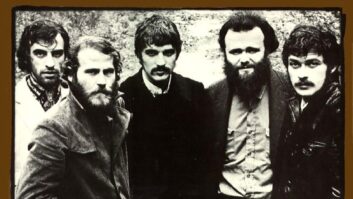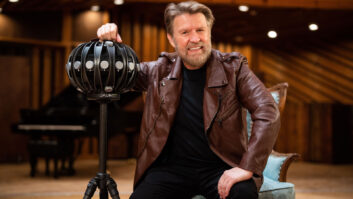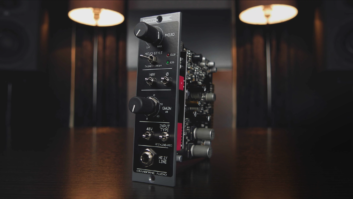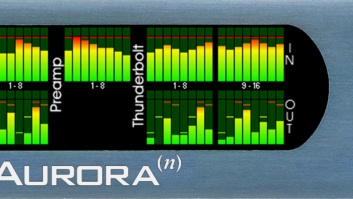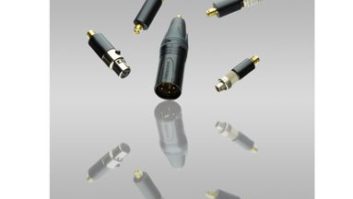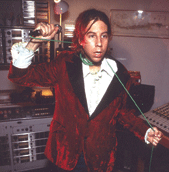

It’s a fact, right? Creative recording is a dying art. With the bulk of the music business still dominated by quarterly statements, cookie cutter soundalikes, desperate litigation and low-talent video star “singers,” there’s a lot of paint-by-number recording going on. Hey, it’s the music business — there’s no time for experimenting! But don’t despair — there are a few Don Quixotes out there recording for the love of it. This year’s “Radical Recording” panelists are proof that there are still brave souls in the trenches, pushing the creative envelope and searching for sonic nirvana. Here’s to an infusion of inspiration for us all.
John Vanderslice finds himself often “tied up” in his work.
HI-FI MEETS LO-FI
Artist/producer/engineer John Vanderslice gained fame as an indie pop/rock innovator with his band MK Ultra and critical acclaim with his three solo releases, including Cellar Door in 2004 and the notorious single “Bill Gates Must Die” from the 2000 Mass Suicide Occult Figurines. The San Francisco-based Vanderslice remains addicted to analog: A 24-track Studer 827 holds place of honor at Tiny Telephone, his 1,700-square-foot studio that’s been dubbed, by the San Francisco Bay Guardian, “Best Studio to Record Your Indie Masterpiece.” TT hosts an eclectic roster of in-house producers and engineers, including Justin Phelps, Bob Weston, Chris Walla and Vanderslice’s partner-in-crime, Scott Solter, ensuring constant traffic from some of the hippest bands around. Vanderslice himself just naturally thinks outside the box: A goldmine of tips and tricks, he dug into his bag to share a few.
One frequent Vanderslice/Solter recording strategy involves what they call the “wild card track.” “Say you’re recording drums,” Vanderslice explains. “We usually try to limit ourselves to four or five mics on a drum kit, but we also use an aux send to bus the drums to a Spectrasonics 610 compressor or an Ampex MX10 mixer that we’ll hit really hard. That gives us an explosive sound that we can blend in under the normal hi-fi drums. A UREI 1176 will work for this, too, but the 610, especially when the red lights are going off and the meter is buried, is the best. Blending in this wild track provides a lot of sonic tension or dissonance. It’s great for texture. A little goes a long way.”
A variation on the theme works for horns. For a small horn section or solo trumpet, a track distorted through an Ampex 351 mic preamp gets comped with the clean tracks. “We mix it so you don’t hear distortion,” Vanderslice relates. “What you get is a thickness, like the gutsy sound of a late-’50s recording.”
For strings, Vanderslice suggests doing two passes, using small-diaphragm condenser mics — Schoeps 221s or CMC65s — for the first pass and ribbon mics like Beyer 160s on the second. “When they’re combined,” he says, “the ribbon mics fill out the midrange nicely. They’re softer and they carry the low mids differently than the condensers, making for a much richer sound than you’d get with just condensers.”
A Neumann SM69 stereo mic with rotating capsules lends itself to some cool variations. Vanderslice aims both capsules at the same sound source, then records one clean and one processed. “This can be very effective on vocals,” he notes. “One capsule can be compressed and the other left flat. When you blend them, you retain all the transients of the uncompressed track.”

Artist Paul Westerberg (right) kept producer/engineer Matt Wallace on his toes while recording 14 Songs.
Passive filters are a favorite Tiny Telephone tool; Solter has a collection of antique ADC and Cinema Engineering theatrical filters that are, Vanderslice notes, “basically just shelving EQs. We’ll take one or two of the drum kit mics, put them into the filters and take off a lot of the top end. That gives a murky, submerged sound to the drums, something that’s neither modern nor ‘old-timey’-sounding. It’s just unplaceable, very useful when you want some atmosphere.”
TT boasts an EMT 140 plate reverb, which, because it’s housed in the live room, gets some non-traditional use. “If something loud is playing, like drums, electric guitar or timpani,” Vanderslice notes, “it will bleed into the plate. When you check it out in the control room, it can sound very beautiful.”
Going analog means access to varispeed on the tape recorder, another TT signature tool. “We do off-speed recording on instruments all the time,” he says, “sometimes by only five to 10 percent. When you bring those varispeeded instruments back to normal pitch, they sound a little bit skewed. An acoustic guitar recorded up 15 to 20 percent will sound very rubbery when you bring it down to normal speed, almost like a baritone guitar.”
How to keep those off-speed instruments in tune? Don’t be shocked — “We tune by ear,” Vanderslice confesses. “Sometimes it will be off a bit, which gives a chorus-y, bizarre kind of pitch that you won’t get tuning normally to A440.”
Other analog tricks involve TT’s 1940s Masco P.A. head, Solter’s TEAC ¼-inch decks and overloaded circuitry. “They’re capable of very nice distortion,” Vanderslice notes, “probably because they’re completely overwhelmed by the input level. The holy grail for us is high-quality distortion. It sounds funny, but that’s actually difficult to get.”
Acoustic guitar often gets the benefit of some high — or low! — quality distortion using a Schoeps 221 mic in omni mode. “You can put it in front of any acoustic guitar,” Vanderslice offers. “The quality of the instrument hardly matters because you’re going to destroy it. We’ll put it though a Neve 1073 at a very low gain stage, maybe -30 dB, then send it into an Ampex MX10 or an Ampex 351 tube mic pre. We’ll tweak the input of the Ampex against that of the Neve until we get the right gain matchup — those tubes want to see some heat! Then you back down the output of the Ampex or maybe send it into an 1176 so you have some control. Or you can scale down the input on the MX10 and get a really thick, syrupy hi-fi guitar tone. There’s a lot to play with, between slightly overdriven distortion and 100-percent saturated.
“There’s a tremendous amount of noise from hitting the tubes so hard, so you do have to gate it. The beauty of this technique is that you can work the input and output of both mic pre’s until you find exactly the right amount of distortion for your application. It’s a very flexible way of using both a solid-state and a tube mic pre together to find that sweet spot.”
OLD IS NEW, BACKWARD IS FORWARD
Producer/engineer/mixer Alex Newport is a British expat musician who got into recording when his “loud, fast punk” band couldn’t find anyone to record their music to their satisfaction. “We ended up working in a studio with some hippie who was trying to put a phaser on everything,” he recalls. “As that obviously wasn’t going to cut it, I took over.” Newport’s amassed a slew of credits since then, among them System of a Down, the Mars Volta, At the Drive In and Ikara Colt. A busy guy, he does 12 to 20 albums per year. He also recently opened Hot Head Recording Studios in downtown Los Angeles.

Alex Newport in his recently opened Hot Head Recording Studios (L.A.)
Newport had to be coaxed to discuss recording techniques, insisting that his focus is on song and performance. When pressed, however, he offered anecdotes that justified his reputation for, when necessary, applying out-of-the-box techniques to get results. One of the wildest adventures took place during recording with the notorious Melvins on their 1996 release, Stag. It was on the cut “Goggles” that, Newport recalls, “the band wanted to do everything opposite from how it was supposed to be.
“If you’d normally use a [Shure SM] 57 facing a guitar speaker, they’d want to use a 75 and place it facing away from the guitar amp. Okay, there is no 75, but the objective was clear: the literal opposite,” he says. “I’d take an [AKG] D-112 mic that I’d normally use on bass drum and put it on the hi-hat, then take a small-diaphragm condenser and put it on the bass drum. I EQ’d tons of low end onto the hi-hat and took all the lows off the kick drum. For the vocals, singer Buzz Osborne sang through a little Radio Shack mic into an Ampeg SVT torqued to full, which we then miked.”
Ahem. Did all these tone reversals make for difficult mixing? “It was quite bizarre,” Newport says with a laugh. “At that point in my career, I spent my time trying to keep everything sounding good: a solid low end, a nice smooth high end, everything in phase. Suddenly, the goal was to make the most obnoxious sounds possible. In a way, it was like being a kid in a candy store. I didn’t have to worry about distortion, full frequency response, phase cancellation — in fact, a lot of things were deliberately put out-of-phase to make them uncomfortable to listen to.
“By mix time, we’d gotten to where nothing we did was extreme enough. We fed the vocals into a 4-track cassette with levels slammed; it had something like five levels of distortion, but it was never enough. The Melvins were working with several different producers and engineers; finally, they decided to take the song and try it with someone else, which at that point, was fine with me! As it turned out, when they’d had a bit of rest, they decided it was extreme enough and it ended up on the record.”
These days, budget constraints sometimes limit experimentation. However, when there’s time, there’s plenty of studio gear Newport is willing to abuse. He elaborates: “I like chaining two or three compressors together. The Spectrasonics 610, which is known for being ‘grind-y’-sounding, really goes over the top when you chain two of them together. Another chain of choice is an 1176 into a Spectrasonics; with a bit of level crushing, a radical sound is easy to obtain. I’ll use that on drum submixes and bring it back into the mix.
“The main thing is that the attack should be quite slow on the first compressor in the chain; the second compressor controls the final amount of attack. If you use a fast attack on the first compressor, there’s no transients left to destroy. The Spectrasonics overloads easily; it’s like a distortion box and compressor all in one.”
Newport’s production of Brazil’s A Hostage and the Meaning of Life (Fearless Records, 2004), particularly the cut “Escape,” shows examples of the Spectrasonics/1176 combo. “In fact,” he notes, “it’s almost the entire drum sound, with just a little of the close mics added for clarity.”
Another box Newport favors for drums is the Alesis MicroCompressor. “They’re stereo units,” he comments, “perfect for room mics or drum overheads. For total bombast, I’ll chain two MicroCompressors together. Of course, extreme sounds only work for certain songs. The instrumentation has to make space for it; otherwise, it’s just mud. These effects are better on slower or more sparsely arranged songs.”
Newport is also a fuzz pedal collector; for drums, he might reach for a Big Muff or the Holowon Static Egg, fed through a bus or aux send, then EQ’d and gated. “I’ve also had good luck using a Sansamp bass driver for drum distortion,” he notes. “With judicious use of a gate, you can control the sustain of the drums in a very musical way. The effect is similar to SPL’s Transient Designer, but with a lot more grit!” “Automatic” from Ikara Colt’s 2004 release, Modern Apprentice, is the best example of this sound.
“Especially with today’s gear, where so many of the sounds are emulations or presets, I try for unique sounds. I find pedals more fun than plug-ins, many of which sound generic to me. Half the fun of using pedals and distortion is that you’re using something in a way that it wasn’t intended to be used.”
A final radical thought? “Working with a band called Knapsack, we were searching for a very compressed, unusual room sound. I tried a bunch of compressors but nothing worked, until I hit upon the idea of a using a Dictaphone [a voice recorder used for dictation and messages]. You can put one into record/pause and take a line out. They have this insane brick wall limiter: instant destructo levels! I switched back and forth between the small, distorted, compressed drum sound on the verse and the full, close-miked drums on the chorus.”
A THINKING MAN’S GUIDE TO RAD REC
Producer/engineer Matt Wallace has a long and critically acclaimed discography that’s also laced with a large amount of Platinum. From his early days with Faith No More through work with The Replacements, John Hiatt and Train, to his current success with Maroon 5, Wallace has maintained a philosophy of going for broke to get a great performance. A man on a mission, he constantly challenges himself, and the people he works with, to create vital, exciting music. We caught up with him at his Van Nuys, Calif., studio.
Some of the production techniques Wallace has developed over the years were spawned on projects with singer/songwriter Paul Westerberg and with his former group, The Replacements. The Westerberg album, 14 Songs, was, he recalls, particularly challenging. Part way in, the project took a left turn when Westerberg, while keeping Wallace on as producer, fired the band and engineer, then moved the project from New York to San Francisco. “I realized what a mercurial talent Paul is,” recalls Wallace, “and I was trying to figure out what we were going to do when I walked in on him writing a song on acoustic guitar in the bathroom at RPM Records. I could tell it was really happening. In the equipment I’d brought with me was my Fostex X15 4-track — technically, one of the worst pieces of gear you could own. But I brought it into the bathroom, showed him how to work it and let him record where he was — by himself. It’s a mono recording with tons of air conditioning hum on it, and that’s what we ended up using. I think most people, when they first heard him working on the song, would have said, ‘Cool idea! Let’s go in the studio, set up a mic, get levels and see what happens.’ But in that case, and many others, if you do that, you’re going to lose it. At that moment, the song was being born, right there, and we got it. Plus, when Paul saw I was willing to do whatever it took to get a performance on tape, he really opened up.”
It was also Westerberg who taught Wallace the importance for a producer to stay several steps ahead of the artist. “By the next round of recording, I was ready for him,” Wallace says, laughing. “I’d gotten the band set up. Then, in the control room, just for the hell of it, I put up a Neumann tube U47 on a huge Atlas boom stand, right behind the console. I guessed at the proper gain settings, then swung it out of the way. When the band finished a take of the song called ‘Silver Naked Ladies,’ Paul came in, all excited to hear the playback. He was ready to sing, but he expected me to spend some time setting up a mic and headphones out in the studio. Instead, I swung the mic around in front of the console, turned the monitors up full and said, ‘Let’s go!’ By rights, singing in a control room, with blaring monitors and a mic as sensitive as a U47, it should have sounded terrible. [Eds. note: To prevent feedback, the track being recorded was very low in the monitor mix.] But it kept him pumped up and in a couple of takes, we had a great vocal. Again, it was the moment of inspiration.”
Producing often requires the use of psychological tools — one of them can be jarring a point of view to open the doors to creativity. “I was working on a song with a band called Royal Jelly,” says Wallace. “The guitarist had played a song a bunch of times with the same solo. Finally, he said, ‘I want it to have this swirly, ethereal kind of sound.’ So I picked up a Shure SM57 by its mic cable, swung it around and recorded him while he played. It got him excited, and he played a great solo. I think when artists see you’re as crazy as they are, or that you’re willing to go further than they expect, they open up. They feel like you’re a partner instead of ‘Mr. Goodsound,’ somebody who’s going to show them how it should be ‘properly’ done.
“I often have to drag bands kicking and screaming to do this kind of thing. Sometimes, personally, I don’t want to go there. But you have to trust your instincts. What matters is getting the most inspired, genuine, emotional performance you can out of someone, and oftentimes, that takes really flying by the seat of your pants.”
Maureen Droney is Mix’s Los Angeles editor.

Stuck in a rut? Shake up your routine with these radical tips.


